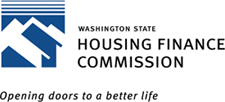- Homeownership
- Multifamily Housing
- Nonprofit Facilities
- Special Programs
- Property Managers
- For Investors
APRIL 2017 | DOWNLOAD PDF | CURRENT ISSUE | PAST ISSUES
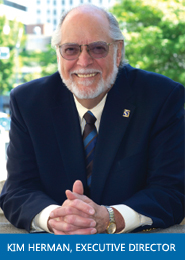
 From
Home to School:
From
Home to School:
The worlds of housing and education are coming together
to support kids

Unstable housing undermines school success
Housing authorities are taking a leadership role to leverage their resources and build partnerships
On the eastside: Priority Spokane
Case Study: Logan Elementary, Spokane
“The other 17 hours”: Superintendent of Public Instruction Chris Reykdal
Conclusion: Hope for the Future
Here in Washington state, we’re seeing a groundswell of partnerships focused on ensuring that homeless and low-income children secure and maintain stable housing, while gaining access to promising educational opportunities and interventions. This issue of My View shares several stories, primarily from a housing perspective, about initiatives aimed at making a positive, enduring impact on the lives of our state’s low-income youth and their families.
These housing/education partnerships, many of which are co-led and co-funded by our state’s housing authorities (HAs), are stabilizing families and strengthening student achievement. In the process, they’re helping both kids and families gain a better chance at a successful future.
Unstable housing undermines school
success
A wide body of research confirms that both residential mobility
(changing homes) and school mobility (changing schools), particularly if
they occur at critical or vulnerable points in a child’s education, lead
to declines in educational achievement.
We all understand this intuitively. It’s hard for kids to learn and feel
emotionally grounded if they’re constantly changing schools, if they
don’t have a stable home, if they don’t have a chance to develop peer
and teacher relationships, if their learning environment is constantly
disrupted. These and many more obstacles to learning are associated with
homelessness and unstable housing.3 These impacts are not only
experienced by “hyper-mobile” students themselves—they are felt by all
the students in a given learning environment.
A 1996 study of Chicago public schools through the University of
Chicago, for example, established that in those schools with a high rate
of student mobility, lessons became more review oriented. As a result,
the pace of new learning slowed to such an extent that by the fifth
grade, “the curriculum at hyper-mobile schools was a year behind that of
more stable schools.”4
Without stable housing, children miss more school, need to repeat grades
more often, and require more special education services.5 Our children
deserve better.
This work is absolutely critical. Just one glaring example: About one in every 30 students in Washington state is homeless. During the 2015-16 school year, that added up to more than 40,000 kids.1 More than half of these homeless children are in elementary school. The statistics on school success (not to mention in future life and career) for children who lack stable housing and are shunted from school to school paint a grim picture. As many studies have shown, there’s a direct relationship between family poverty and low student achievement.2
I believe the critical mass for much-needed structural change can be found in our state’s partnerships. School districts, social services organizations, HAs, municipalities and elected leaders, educational consortiums, academic researchers, private foundations—all are working together to create solutions unique to communities’ challenges and resources.
top of page /\
Housing authorities are taking a leadership role to leverage their resources and build partnerships
In a recent publication describing the preliminary research and objectives of the partnership between Seattle Housing Authority (SHA) and Seattle Public Schools (SPS), researcher Kate Tibone noted:
While most current research focuses on the absence of high-quality, affordable housing and its consequences on children, there is a dearth of research on how housing can be a positive pathway to improve educational outcomes for children.6
Our housing authorities in the Puget Sound area, notably SHA, King County Housing Authority (KCHA), and Tacoma Housing Authority (THA), are creating these positive pathways. They’re focused on disrupting the legacies of childhood poverty, housing instability, and homelessness—while helping ensure that kids get consistent access to the educational resources they need to succeed. All three HAs are working towards these goals in unique ways.
top of page /\
Seattle Housing Authority
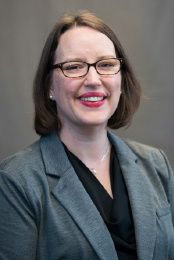
Courtney Cameron
Strategic Advisor for Education, Seattle Housing Authority (SHA)
“Housing is the essential
first step to rebuilding and improving lives … but you can’t stop
there.”
SHA’s educational initiatives are a core part of its mission and philosophy, says SHA’s Communications Director Kerry Coughlin. “We go beyond four walls—that’s truly across the board with our work. Our philosophy at SHA is that housing is the essential first step to rebuilding and improving lives and working towards greater self-sufficiency, but you can’t stop there.”
As strategic advisor for education at SHA, Courtney Cameron is coordinating a vast network of education partnerships and efforts to improve the outcomes of both children and families who live in SHA housing. “We very intentionally said, ‘We want to look at every youth,’” Courtney says.
Addressing the needs of diverse student populations
 The needs of children who live within large SHA properties like Yesler
Terrace, NewHolly, and High Point, Courtney points out, differ from
those of SHA students whose families are housed through the Home Choice
voucher program. SHA already offers many on-site programs in its housing
communities, but Home Choice-housed youth are more dispersed. For them,
the schools are “the anchor for providing support services, enrichment,
extension classes—all sorts of services in a new way.
The needs of children who live within large SHA properties like Yesler
Terrace, NewHolly, and High Point, Courtney points out, differ from
those of SHA students whose families are housed through the Home Choice
voucher program. SHA already offers many on-site programs in its housing
communities, but Home Choice-housed youth are more dispersed. For them,
the schools are “the anchor for providing support services, enrichment,
extension classes—all sorts of services in a new way.
“We work closely with some of the other housing authorities regionally—we’ve learned a lot together,” Courtney says. She and her counterparts from KCHA, THA, Portland Housing Authority, and Vancouver Housing Authority meet quarterly to share practices. Though each HA has the same fundamental aims, “The context for where the work started and where it’s going differs for each of us.” THA, KCHA, and SHA are all engaged in a multi-year Gates Foundation grant, “giving us the funding to have the capacity to focus on this work. That funding is supporting a collaboration that already existed—but it has helped to accelerate this collaboration.”
At SHA, Courtney says, they’re the first to do this education-focused work “in the way that we’re doing it. We’re learning from others nationally, and we’re also leading in certain areas. We’re excited about that.”
SHA and Seattle Public Schools: Accelerating success
SHA is partnering directly with Seattle Public Schools (SPS) on a number of important initiatives. They formally combined forces in the fall of 2014.
SHA houses about 29,000 people, about 6,000 of whom are SPS students. “We serve at least one in 10 public school students,” Courtney says. “These students attend nearly every Seattle public school. That’s a huge driver in the way that we set up our partnership: We share so many students and they are geographically dispersed. We have several schools where at least 20 percent of the students at those schools live in SHA housing.”
To kick off this partnership, SHA and SPS spent a considerable amount of time to build a picture of these students. For example, 66% of their shared students are African American; 25% are English Language Learners (ELL); and 17% are enrolled in Special Education. SHA and SPS convened many different focus groups to listen to concerns and questions from principals, school staff, communities, and families. Ultimately, they arrived at three systems-level areas of focus, which the SHA/SPS partnership is now targeting. These are:
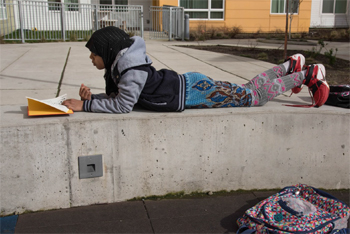
A student reads at SHA's Kebero Court.
Dual-Generation Supports. “We’re approaching this by thinking about the
whole family and the skill achievement for youths and adults,” Courtney
says. “When adults have higher levels of education, that has an
absolutely positive impact on youth in the household.”
These interventions include a new Workforce Opportunity System that
helps adults determine the skills they need to work in fields that are
offering readily available good jobs. Other programming includes
activities for families that target financial literacy, and adult
workshops that empower families to navigate the school system and create
a college-aspiring culture at home.
Evaluation. The partnership is creating a data-driven service delivery
model that includes population-level data, Courtney says, “knowing where
people are and how they’re doing, and looking specifically at academic
outcomes for the youth we house.”
Acting as allies for bold policy and systems change. The vision here is working together at the systems level in new ways to help ensure that low-income families have the same access to educational opportunities for their school-aged children that higher-income families have. One example: SHA/SPS is piloting a landlord partnership to help Housing Choice families who want to live where their kids can attend high-performing schools.
A wealth of partnerships
Implementation of these Seattle School District-wide strategies began in fall 2015. One of the challenges of such a huge undertaking is how to implement it across such a large and diverse region.
Courtney talks about learning from the successes of other SHA education partnerships in more focused geographies. For example, students in SHA’s NewHolly development are being positively impacted as a result of a SHA/SPS collaboration with community partners who provide youth services at NewHolly and its five neighborhood public schools. This work was also launched in fall 2015, funded by a federal Race to the Top Deep Dive 3 Community Partnership grant.
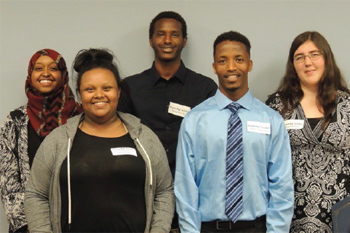
Each year, SHA awards Dream Big! Scholarships of $1,000 each to
outstanding college-bound youth who’ve been living in SHA-assisted
housing. Pictured are five of the seven 2016 awardees.
She also points to SHA’s long-running partnership with Seattle University, funded in part by a Choice Neighborhoods grant through HUD. The focus of the grant is on Yesler Terrace, an historic SHA housing development just east of downtown Seattle, along with a portion of the surrounding low-income neighborhood. SHA and the grant team prioritized educational improvements in the neighborhood and its local elementary school, Bailey Gatzert, collaborating with multiple partners, including Seattle University, SPS, and child-centered private and public agencies.
“We’re very fortunate to work with Seattle University on the Choice Neighborhood grant,” Courtney says. “They’ve been a huge education partner as part of that entire grant. Great things are happening at Bailey Gatzert, through to Washington [Middle School], to Garfield [High School].”
Kerry adds, “We have a high interest in the success of Bailey Gatzert. Seattle University’s Youth Initiative there is making a real difference in outcomes in reading and math achievement.”
A HUD article describes the Choice Neighborhood partnership:
The partnership in Seattle embraced the cradle-to-career approach to “ensure low-income children in the Yesler neighborhood have access to early learning programs, tutoring, summer academic enrichment programs, college preparation mentoring, and scholarships. These resources are meant to complement the learning that happens in the classroom.”7
Additionally, partnering with SPS and the City of Seattle, SHA launched the Home from School pilot last September, also centered on Bailey Gatzert. “Home From School is working specifically to house homeless families within that school’s catchment area, to bring stability to the school and to the families,” Courtney explains.
In terms of creating programs that can be effective across the SPS district-wide partnership, the two organizations are currently in the process of determining what they can take to scale and replicate—or what may be unique to a particular community.
Courtney singles out attendance as an example of a concerted, district-wide effort. SHA-housed students are not attending school at the same rate as the district average. “We’re digging into why, what that means, and what we can do about that.”
There just isn’t room here to mention all of SHA’s education programs, but two initiatives shouldn’t be overlooked. The first is SHA’s tutoring programs, supported by great partnerships with Catholic Community Services (CCS), East African Community Services, Somalian Family Safety Task Force, and other organizations. The partnership with CCS alone serves about 450 students each year. SHA and CCS are looking to bring more volunteers into the tutoring program.
And lastly, Courtney points to “some great success stories of youth who have grown up in SHA housing and are going on to do incredible things.” SHA has launched a youth column in its publication to all residents that features these students’ experiences. “We’ve been talking about the gaps, but we also have great successes. We’re working to figure out how to replicate these paths of success for other students, too.”
top of page /\
Tacoma Housing Authority
Michael Mirra, THA’s executive director, has served as a champion for homeless and low-income kids in our state for decades.8 A cornerstone of THA’s strategic mission, Michael explains, is supporting the people they help house “to succeed—not just as tenants, but as parents, students, wage earners, and builders of assets. We want them to come to us, have a transforming experience in those ways and then move on. We want this certainly for adults, but emphatically for children. We do not wish them to need our housing when they grow up. This requires school success.”
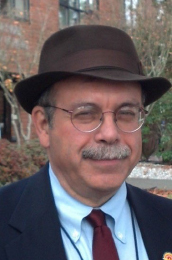
Michael Mirra
Executive Director,
Tacoma Housing Authority (THA)
“We do not wish [children] to need
our housing when they grow up. This requires school success.”
Integral to this project is the goal of stabilizing schools themselves. Students don’t succeed or fail in isolation, Michael points out. Homeless and low-income children bring special challenges into the classroom, and schools charged with teaching these children require focused solutions and support. “We think the school district has a claim on our help,” he says.
So THA began working alongside Tacoma Public Schools (TPS), teachers and decision makers, community leaders, private funders, and parents. In Michael’s words, “This is an effort to find ways to spend a housing dollar not just to house people—but to help the children we house to succeed in school, and promote the success of schools that serve low-income children.”
THA’s Education Project, launched about eight years ago, now includes a number of initiatives. One of them is such a visionary, ambitious undertaking that I think it deserves closer examination.
The McCarver project: Helping the schools succeed
When THA began to look over school district data, McCarver Elementary in Tacoma’s Hilltop neighborhood stood out.
“Its population of students was the poorest in the region, possibly the state. It had more homeless students than any school in the region, probably the state, so it had all the miserable school outcomes that we have come to expect from schools like that,” Michael says. McCarver’s transient rates were “ruinous to the school outcomes of the children who come and go, as well as their classmates.”
Students’ annual turnover rate had ranged between 101 and 179 percent between 2005 and 2011.9 Teacher turnover was fairly high as well.
The McCarver program was launched in 2011 after extensive planning. It encompasses:
- To help stabilize the school, THA provided rental assistance to 50 homeless McCarver families. At its outset in 2011, the 85 children in the program made up 20 percent of the student population.
- The program requires participating parents to keep their children at McCarver, participate actively in their kids’ education, and invest in their own education and employment.
- Supportive services, including those through two THA-funded caseworkers based at the school, are provided to help parents keep their commitments.
- Tacoma Public Schools made a significant investment in McCarver to transform it into an International Baccalaureate (IB) program.
- A third-party evaluator, funded by the Gates Foundation, tracks the
program on a wide array of metrics.

Vancouver is also creating strong links between housing and education.
It was one of three cities profiled in a
2015 nationwide research report
from the Urban Institute for Vancouver Housing Authority’s (VHA)
innovative partnership with Vancouver Public Schools (VPS) to reduce
students’ chronic absences and improve stability. As a Moving-to-Work
agency, VHA has used its increased flexibility to fund joint initiatives
with VPS, for example to provide housing vouchers to families who work
with VHA on self-sufficiency and with VPS on school engagement for
children.
The work complements innovations at VPS, particularly the establishment
of Family-Community Resource Centers located at schools which can refer
families to housing and to a wide range of other services.
You can read the Urban Institute study at www.urban.org (enter
“Vancouver” in the search field).
After five full years, many positive results for these students and families stand out. For example, the transient rate for the children in the program’s cohort is down below five percent. McCarver’s transient rate overall is also down, to 82 percent, which is better than simply the impact of stabilizing those 50 families. “We don’t know what got it down further,” Michael says. “We’d like to think it’s because if you stabilize the core of the chaos it has a school-wide benefit. Or perhaps the IB program made the school more appealing to a wider array of parents. No doubt there are a lot of factors at work.”
Another key metric: After just two years, the reading scores of the cohort children rose three times faster than comparable cohorts. Also, on average, the earned income of the participating parents doubled. “That’s very encouraging,” Michael says, “although a closer look at the data reveals that about one-third of the parents did very well, one-third did so-so, and one-third made zero progress.” He notes that the lack of progress by these ‘lower-performing’ parents can largely be attributed to the deep challenges they faced, including mental illness, drug and alcohol dependency, and serious trauma from domestic violence.
What’s next for the McCarver program?
Where does the McCarver program go from here? Even when their parents were contending with the challenges mentioned above, the children still showed educational gains. In general, the McCarver data show promising results from the cohort children and parents, along with mixed results about the school-wide effect.
The data led TPS and THA to two decisions last year. The first was to turn the McCarver Program from a pilot to a regular offering of the school. And the second was to expand it to other Tacoma elementary schools with similar housing instability.
Right now, the program’s partners are planning that expansion to account for what worked and what didn’t. For example, how to approach supporting that one-third of families who are deeply challenged? One likely answer is “to do a better job linking them with the clinical services they need.
“Under the present model,” Michael adds, “we’ve asked parents to commit to the school. That’s a problem if they can’t find housing in the school’s catchment area, so we may consider some flexibility there.”

THA staff person Carlena Allen supervises students participating in
McCarver Elementary’s Read2Me program, which pairs them with an adult
tutor for 45 minutes a week. The goal is for every child in the program
to read at or above their grade level by end of third grade.
TPS has agreed to pay the additional new caseworkers’ salaries, but the program’s main expense is the housing dollars: about half-a-million dollars per school per year. “We don’t count that as a cost,” Michael says. Regardless, “we would be spending those housing dollars to house families with a focus on the neediest. We’re spending the same dollar but in a different way—not only to house a needy family but to also get these educational outcomes. We count it as a very good use of the housing dollar.”
Deeply invested in education
I also want to share the breadth of THA’s programs. These include:
Educational Services in THA Communities. The school district’s only Head Start program is housed at THA’s new Bay Terrace property. Mentoring and tutoring programs, and computer labs are offered at THA housing, as are THA’s summer lunch and literacy program. And free books for kids abound throughout THA’s properties and interactions—“our version of Boston Medical Center’s Reach Out and Read program.”
College-Bound Scholarship Enrollment. The Washington State College Bound Scholarship Program is a commitment by the legislature to every low-income student in the state. But, as Michael explains, students must sign up for it by the end of their eighth-grade year. THA has enrolled 100 percent of its eighth graders every year for four years in a row. THA also participates in an aggressive citywide enrollment effort that takes place in the middle schools.
Children’s Savings Account Program for Students of New Salishan. This program partners with TPS, Heritage Bank, the YMCA, and the Corporation for Enterprise Development. This is a college-savings match, financial literacy, and college-planning program for every child living at THA’s New Salishan community. Students who participate fully graduate from high school with $9,700 in their college savings account.
Only a small percentage of low-income students pursue a post-secondary certificate or degree program—and even fewer actually graduate, Michael points out. “What defeats our children financially are the non-tuition costs of attendance, and the fact that these children and their families, starting young, make the pre-judgment that college is not for them, that it’s not attainable,” he explains. “Children with savings accounts starting young are four times more likely to graduate from college.”
Tacoma Community College (TCC) Housing Assistance Program. A surprising number of Tacoma Community College students are homeless. Two years ago, THA started a pilot that offers rental assistance to homeless TCC students. The assistance lasts until graduation or three years, on the condition that the students make adequate academic progress towards a degree and maintain a GPA of at least 2.0. THA granted assistance to 25 applicants, while also tracking those they turned away.
On measures of both higher GPAs and enrollment rates, the program is a success. Right now, THA is planning this program’s expansion. They’d like to house more students, Michael says. THA is also considering creating a new program for women who began their TCC studies while in prison at Purdy or Mission Creek and wish to continue their education after release. Bates Technical College and University of Washington Tacoma are also looking to partner with THA to house homeless students.
Once you gain a reputation as an education innovator, the opportunities—and the possibilities—keep knocking.
top of page /\
King County Housing Authority
Twenty-thousand children live in housing provided through KCHA. Many of these children’s parents are immigrants or refugees. Before receiving housing assistance, more than 50 percent of these families were homeless. Ted Dezember, who is senior manager of educational initiatives and youth programs at KCHA, views KCHA’s education work “as an equity initiative—an opportunity to collaborate with school districts and others to make sure that as a community we’re not neglecting low-income, underrepresented, underserved people.”
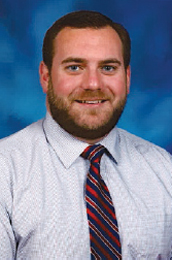
Ted Dezember
Senior Manager of Educational Initiatives and Youth Programs, King
County Housing Authority (KCHA)
“We house people. We’re not
necessarily experts in education, but what we can do is be a connector.”
Though he comes from an education background, Ted says, “the reality is that here at KCHA, we house people. We’re not necessarily experts in education, but what we can do is be a connector. We want to leverage the role that we have with families and with other community-based partners, to work together with the schools. It’s really about thinking about how we can best utilize all of our opportunities to improve outcomes.”
Supporting partnerships across 17 school districts
One of most challenging aspects of Ted’s role is the number of school districts that serve the youth living in KCHA’s properties across the region: Seventeen. Like their fellow travellers at SHA and THA and elsewhere, KCHA’s education work is necessarily tailored to the needs and unique attributes of the communities they serve.
KCHA helps sponsor many place-based initiatives that focus on discrete communities and their school districts. Head Start classrooms are housed on KCHA properties in Kent and White Center. Other programs include:
Bellevue’s 148th Street Corridor. Club 368 provides homework help and mentoring for middle schools. The program is a partnership among the Boys & Girls Clubs of Bellevue, the Bellevue School District, and KCHA.
Kent’s East Hill neighborhood. At three KCHA housing sites, the Read to Succeed program focuses on early learning. KCHA, the Kent School District, Kent Youth and Family Services, and other partners are focused on ensuring that all students can read at grade level by the third grade.
White Center. The Greenbridge Learning and Engagement Advocacy (GLEA) program works to establish an early foundation for children’s academic success—beginning in their very first year of life. And the White Center Education Initiative brings together Highline Public Schools and service providers, with the goal of all KCHA-housed youth meeting the reading standard by the end of third grade.
KCHA is also a partner in the Road Map Project, the region-wide initiative originally launched with $40 million in federal Race to the Top funding in 2012. The big-picture goal of the Road Map Project is to double the number of students in South King County and South Seattle who are on track to graduate from college or earn a career credential by 2020. The region covered is home to 71% of King County’s low-income students. Except for South Seattle, KCHA shares the same geographic territory as the Road Map Project, including six school districts.
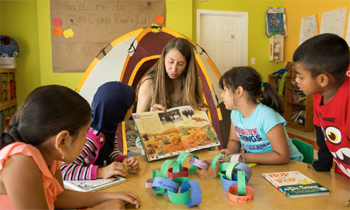
Cara Ianni, KCHA education programs coordinator, reads with
elementary school children during summer programming at the New
Futures Community Center located at Windsor Heights in SeaTac.
As a Road Map Project partner, Ted says, KCHA is committed “to take the learning and support of our partners and our school districts in implementing or utilizing the innovations they’re pushing forward.” Whether it’s getting the word out about kindergarten registration by sponsoring events on KCHA properties, or supporting out-of-school programs, or focusing on early learning and school attendance, “we’re involved in work groups and collaboratives to help leverage what’s being done collectively across the region.”
Another KCHA partnership is with Eastside Pathways, a Collective Impact program similar to the Road Map Project. Eastside Pathways began in the City of Bellevue, in the eastern part of King County, and has expanded into the Lake Washington School District as well. Like Road Map, Eastside Pathways is a cradle-to-career initiative aimed at supporting children to reach their fullest potential. “Collective Impact is a big part of our work. Ultimately, the more we can support the community and what they’re doing, the more that’s going to benefit our families.”
The GLEA pilot
The GLEA program at Greenbridge is a unique, early education-focused project KCHA is spearheading in the White Center community. Its launch and ongoing support to track outcomes have gotten a big boost from the Gates Foundation. “Gates was interested in supporting investments to dig into housing/school partnerships,” says Ted. When looking at the data, and in conversations with the principal of White Center Heights elementary and the Director of Early Learning in the Highline District, what emerged was a large disparity in kindergarten readiness between KCHA and non-KCHA-housed students.
“Based on the data, and the momentum and energy in the district around early learning, we decided to tackle kindergarten readiness for these children,” Ted says. A long planning process ensued: “We pulled in many community partners, including King County Public Health, Educare Seattle, Puget Sound Educational Service District (PSESD) and many others.” The team then travelled to New York to observe the work of the Harlem Children’s Zone and learn about their pipeline approach to education.
“All of us knew what the problem was and what we basically wanted to do. But the great thing about going to the Harlem Children's Zone was actually seeing a model of what that could look like. We modified their Baby College program to make it work for our local context,” Ted explains.

To support children and families KCHA upgraded or built new
community centers at a number of its properties. These children are
participating in an afterschool program housed in a new community
building at the Woodridge Apartments in Burien.
The GLEA program began with residents of KCHA’s Greenbridge community in White Center in South King County. The first cohort of babies and families began the program in fall 2015: 17 families with 26 children aged three and under. The majority of parents were born outside the U.S.
GLEA is envisioned as an early learning program, and is designed to help families begin a relationship with their local elementary school when their children are infants. Twice a year, in the fall and spring, the GLEA program holds its nine-week Baby Academy for newly enrolled families. The Academy consists of weekly workshops, and includes home visits as well as gatherings with other participating families. After their children reach the age of three, families are supported to transition them to intermediate programs like ECEAP (Early Childhood Education and Assistance Program) or Head Start. They are also supported with registering and transitioning them into kindergarten.
There’s a lot of excitement generated by GLEA right now, Ted says. The program has expanded to Mount View Elementary in White Center, and opened up to families who are housed through the Home Choice program. KCHA and its partners are discussing scaling it up even further. “One of the most powerful pieces are the stories that we hear from the participants,” he says. “I think the most unique aspect is that you have a school district and a building principal—in this case, two building principals—calling these one-year-old babies their students, and claiming them.
“The families and the parents participating in the program become part of the school family. Our objective is that every family has a high-quality early learning opportunity and that ultimately, kids are entering kindergarten scoring six out of six on the domains measured by the WaKIDS Kids Assessment.”
Pooling resources
Having so many committed partners makes a huge difference to ensure that these initiatives have the support they need to continue. Ted points to the benefits of HUD’s Moving to Work (MTW) program, which gives participating HAs the ability to innovate while making reforms that help promote employment and self-sufficiency for HUD-housed families. “For organizations like KCHA that qualify for MTW, it’s a tool that helps us take on our education work. This speaks to the need for these types of policies around innovation for HAs and others, that enable them to leverage all of their resources to support kids and families.”
In summing up KCHA’s education work, Ted remarks: “How many times have I said the word partners? I can’t begin to say how many we work with, but hundreds. There’s great work happening in this housing and education nexus.”
top of page /\
On the eastside: Priority Spokane
The Priority Spokane partnership has built significant support in Spokane County. It offers a great example of how a broad spectrum of individuals, leaders, and community organizations, working together, can both identify and address the needs they see as most critical for those who live in their community.
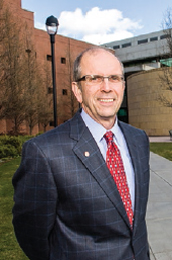
Patrick Jones
Chair, Priority Spokane
“Having buy-in from our mayors–in
particular our current mayor–along with our county commissioners and
Spokane’s City Council, has been essential.”
Priority Spokane’s current pilot aims to reduce the number of homeless students in K-8th grade in Spokane County. Its larger goals are to reduce depression and trauma for these youth—and raise their rates of high school graduation. Right now, Priority Spokane’s partners are facing a huge barrier: limited housing resources. Spokane Housing Authority (Spokane HA) is working on an innovative solution.
Compelling data give rise to community priorities
But first, some background. Patrick Jones is Priority Spokane Chair as well as executive director of the Institute of Public Policy and Economic Analysis at Eastern Washington University. Priority Spokane got its start from compelling data, Patrick explains. The Community Indicators Initiative (CII) of Spokane is a large data site maintained by the Institute that tracks information about the community on a range of measures. “Priority Spokane came about as people were asking us to act on the gaps that the Indicators showed about our community,” Patrick says.
A Steering Committee made up of many of Spokane’s leaders has helped to direct Priority Spokane’s efforts. This includes mayors, City Council members, county commissioners, business leaders, and leaders representing nonprofits, foundations, and community organizations.
In choosing its priorities, Priority Spokane reaches out to its community through focus groups. The first priority chosen by the group in 2009 was high school graduation rates. They worked on that for five years. In 2006 the Spokane Public Schools’ graduation rate was less than 60 percent. By 2013 it had risen to nearly 80 percent. Priority Spokane was awarded a Robert Wood Johnson Culture of Health Prize in 2014 for its efforts.
Priority Spokane’s work “is an ad hoc effort,” Patrick says. “As such, we do have challenges in keeping it going.” He credits the high level of commitment from the region’s leadership as a big factor. “Having buy-in from our mayors—in particular our current mayor—along with our county commissioners and Spokane’s City Council, has been essential.”
Boosting outcomes for homeless youth and families
Priority Spokane held another round of focus groups in 2013, which pointed to mental behavioral health as a key concern. But this vast topic required narrowing. With data showing the mental stress of homelessness on young people, the group decided to focus on housing stability for youth and families.
Dave Scott, Director of Housing Assistance Programs at Spokane HA, serves on the subcommittee that helps direct Priority Spokane’s efforts. “We commissioned an extensive study that identified the amount of homeless or doubled-up families at risk of becoming homeless,” Dave says. These numbers “really caught some people off guard.”
The study revealed that more than 2,000 students are homeless in Spokane County. In 2014, more than 28 Spokane County schools had at least 25 homeless students. Delving more deeply into the data: Over 50 percent of these homeless 8th graders described having felt sad or hopeless every day for two weeks. And more than 22 percent had attempted suicide at least once in the previous year. Spokane County’s homeless students’ academic challenges are numerous, including 45 percent missing at least four days of school per month, and 45 percent having a GPA under 2.0.
top of page /\
Case Study: Logan Elementary, Spokane
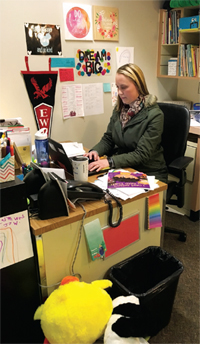 Jessica Sotl’s office has the small chairs, colorful toys and
inspirational posters you’d expect to see in an elementary school
counselor’s office. But it also has piles of boots and coats and stacks
of supplies for food and hygiene.
Jessica Sotl’s office has the small chairs, colorful toys and
inspirational posters you’d expect to see in an elementary school
counselor’s office. But it also has piles of boots and coats and stacks
of supplies for food and hygiene.
That’s because even these basics are beyond the reach of many students’
families. Logan Elementary is the highest-poverty school in Spokane
County. Of its 451 students, 91% are eligible for free and reduced
lunch. Intergenerational poverty is pervasive.
But the biggest impact on Logan is its 40% mobility rate. That means 40%
of students who start the year in September will be gone before June.
“It’s hard to get a sense of who a kid is,” says Jessica. “Sometimes
you’re just getting a handle on that and boom, they’re gone. Sometimes a
kid has been to five or six schools in one school year.”
This high mobility is driven by housing instability—and it’s why Logan
was “so excited to get the Priority Spokane grant,” says Principal Brent
Perdue.
The program pays for both a half-time academic counselor and a full-time
community health worker who connects families to housing and other
resources.
In December 2016, just a few months into the pilot, community health
worker Georgianna (“Georgie”) Tarrant had identified 26 families for
engagement and had already helped five or six of them gain stable
housing.
“Georgie has a wealth of knowledge about where I can send families for
help,” says Jessica. “When we hear ‘we got kicked out last night’ or ‘we
can’t stay with auntie any more,’ we can refer them to Georgie for
housing help that I can’t provide. Previously, I was trying to refer to
outside agencies, calling around for help, etc. Having someone in
housing is a big, big difference.”
Georgie described the challenge of building trust with families, calling
it the biggest challenge of the job. The next biggest challenge:
Actually finding available housing in an area with a 1% rental vacancy
rate. “And then many of them have evictions, credit problems, unpaid
bills and such that make it harder,” she adds.
Still, she’s having success. “Last week I housed a mom with three kids,”
she says. “I was there when she signed the lease.”
Georgie also signs families up for health insurance and knows where to
send them for food, clothing and other help—all the “little” things that
stabilize a family.
School counselor Jessica says the program has opened her eyes to the
role of housing issues in the lives of struggling kids. “I had no idea
how impacted some of our kids and families are, how severe these issues
are,” she says.

Right:
Brent Perdue, principal of Logan Elementary, leads the high-poverty
school as it seeks to improve family stability.
The group responded by formulating a three-year pilot program to place housing experts in schools to work with families identified as homeless or very unstable. With funding limited, two schools were selected to participate: Arcadia Middle School in rural Deer Park and Logan Elementary in the City of Spokane.
The housing experts are two community health workers (CHWs) with Catholic Charities Spokane (CCS) who, at the beginning of this year, were working with 20 families at Logan and 12 in Deer Park. Interventions have included connecting the families with housing and other resources, creating a financial security plan with them, and targeting financial assistance to meet their immediate needs. As more funding is made available, the objective is to expand the pilot to additional high-need schools and families.
Constrained by available funding
As Ted mentioned earlier, HUD’s Moving to Work (MTW) demonstration program enables HAs to target their funding to people who are the most vulnerable, and to programs that best address their community’s most pressing needs. But non-MTW HAs like Spokane don’t have that flexibility.
“Like every HA that is not an MTW, we are required to go through our waiting list,” says Dave. Currently that waitlist has about 3,800 people on it. Under HUD regulations, the families targeted by Priority Spokane can’t move to the front of the line for Housing Choice vouchers, despite the fact that their need for housing is so compelling.
The City of Spokane is providing some assistance through its City Home Program. Through this program, the city contracts with Spokane HA to provide housing for a two-year time period to designated populations. The program was originally created to help house homeless people with serious health issues, along with those who are high utilizers of EMS. Based on the high need for housing for homeless students and families, “We worked with the city to use our contract and those dollars to tie it to the Priority Spokane pilot program,” says Dave.
When I spoke with Dave, six of the most vulnerable pilot families, identified through the CHWs, were either looking for a unit or already housed on a subsidy, thanks to City Home Program dollars.
Creative solution: The Referral Voucher Program
But the need is far greater than the City Home Program’s capacity. Spokane HA is now in the process of leveraging a program they’ve created, the Referral Voucher Program, to help house these homeless families. This program is designed to give them MTW-like flexibility.
Under the Referral Voucher Program, Spokane HA has contracted with nine Spokane nonprofit agencies to administer about 25 Housing Choice vouchers that become available each month. These vouchers open up as individuals and families exit the Housing Choice program in Spokane. Typically, about 50 vouchers become available every month; these agencies have taken responsibility for administering half of them.
Under the Housing Choice voucher program, “we can’t require any kind of stipulation whatsoever,” says Dave. But the beauty of the Referral Voucher Program is that the contracting agencies can. These stipulations include requiring a Responsible Renters class for those who obtain vouchers through the referral program. The agencies help applicants complete the HA paperwork and obtain all of the required documentation. They also help with the housing search, landlord communications, and signing the lease.
The Referral Voucher Program has been a spectacular success in cutting through paperwork, prioritizing needs, and ensuring the community’s efficient utilization of these vouchers. For example, for those on Spokane HA’s standard waiting list, the success rate of actual lease-ups is just 35 percent and the average time to lease-up is more than six months. Under the Referral Voucher Program, lease-ups have increased to about 85 percent, and they take place within about 45 days.
And significantly, the Referral Voucher Program enables Spokane HA to direct housing support to community-critical needs. “The program reaches the disabled, families with children, those experiencing domestic violence. It helps us target the populations of greatest need, to utilize a long-term voucher and have long-term success in housing them.”
When Dave and I spoke, he and his team had just circulated an RFP to agencies willing to administer 10 new vouchers per month targeted to Priority Spokane’s current initiative. The scoring will be structured to emphasize homeless and doubled-up youth and families. “What we want to see is a collaboration between an agency and a school district, working with our liaison, where we can fulfill another 10 vouchers per month to house these homeless youth and in the process, support their education.”
What does HUD think of the program? HUD audited it and loved it, says Dave. “They’ve never seen anyone utilize these vouchers in the way we’re utilizing them in our region, staying within the regulations while also being able to step outside of the normal course of action to deliver them.
“[Spokane HA Executive Director] Pam [Tietz] is very innovative when it comes to figuring out how we can get our assistance where it needs to be. She has been instrumental in building our HA into a broad collaboration with other community partners. These vouchers are a gift—to help the people in our community. We’re always asking: How can we make this work?”
top of page /\
“The other 17 hours”: Superintendent of Public Instruction Chris Reykdal
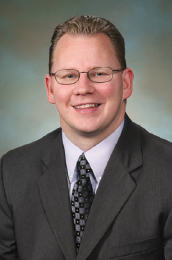
Chris Reykdal
Superintendent of Public Instruction, Washington State
“Our job is to help create sustainable lives
for our students.”
In January 2017, the official count of homeless students in Washington state rose from 35,511 to 39,671. This number, as state Superintendent of Public Instruction Chris Reykdal points out, has risen for eight consecutive years—nearly doubling since the 2008-2009 count.
Chris, who was sworn into his role in mid-January, is laying out strong priorities. “Our agency has a single fundamental goal: to graduate 100 percent of our students on time with a quality diploma.”
The biggest barrier to students’ success, he points out, “is what’s happening in the 17 hours of their lives when they’re not at school. It’s fundamental to our success that we have partners in food security and housing and mental health and a host of other essentials that enable kids to be safe and housed so that they can achieve academically.”
Chris sees the role of his office as working from “a whole child perspective. Our job is to help create sustainable lives for our students.” Under the provisions created by the Homeless Student Stability Act, passed by the Washington legislature in 2016, state funding has been made available to help stabilize homeless students and families.
For school districts that want to take on more innovative approaches in partnering to house homeless students, Chris says his office, in turn, is looking to take a more active role in getting them partnered with housing options through the act’s Housing Partnership Grant Program.
“As a kid who grew up in poverty with two parents with an 8th-grade education, these concerns are very real,” Chris says. “Housing issues are very much part and parcel to students’ success.”
top of page /\
 Hope for the Future?
Hope for the Future?
Clearly, the connections between housing stability, being successful in school, and becoming more successful in life are being demonstrated by the active partnerships in Washington. I sincerely hope that as the new administration in Washington, D.C., takes stock of what’s working to help children, parents, schools and communities be more successful, these programs will be supported and grow here and across the nation. The children of Washington state and the nation deserve nothing less.
1.
Washington State
Superintendent of Public Instruction, 2016 Update of Homeless Student
Data, www.K12.wa.us/HomelessEd.
2. Lacour, Misty; Tissington, Laura D., “The
Effects of Poverty on Academic Achievement,” Rutgers, May 2011.
3. Maya Brennan,
The Impacts of Affordable Housing on Education: A Research Summary,
Center for Housing Policy, May, 2011.
4. Op. cit.
5. Saahoon Hong, & Kristy Piescher, “The role of supportive housing in
homeless children's well-being: An investigation of child welfare and
educational outcomes," Children and Youth Services Review,
August 2012.
6. “Seattle
Housing and Education Partnership Research Report,” August 2015.
7.
Choice Neighborhoods: Placing School
Improvements and Student Achievement at the Center of Neighborhood
Revitalization. HUD Issue
Brief #2, September 2014.
8.
In a 2010 issue of My View, I wrote about his dedicated
work as lead attorney representing the Washington State Coalition for
the Homeless (WSCH) in its nine-year lawsuit against Washington state
during the 1990s in what became known as the “Children’s Lawsuit.” WSCH
demanded, and eventually won in late 1997, deeper and more comprehensive
responses at the state level to the challenges faced by homeless foster
kids as well as families experiencing homelessness.
9.
Tacoma Housing Authority Education Project Summary, Nov. 16, 2015.
